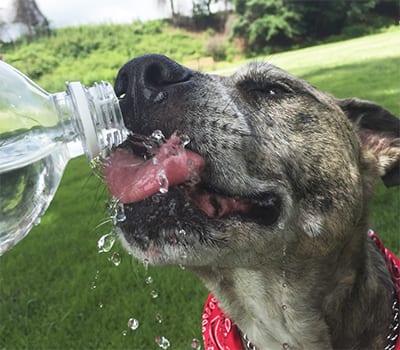
Heat Safety Tips For Cats and Dogs in Altadena
Altadena is one of those lucky few places to have mild, warm weather all year long. Yet our pets may have different ideas of what’s “mild.” With their fur coats, they can get overheated much more quickly than we do, meaning summer can be a challenging season for them. Not only that, but their bodies do not sweat like us. They can only release heat through panting and drinking water. To help you both enjoy the great outdoors even through the heat of summer, our animal hospital team has gathered several heat safety tips for dogs and cats!

Follow These Tips to Stave Off the Heat:
- Water and shade. Cats and dogs cool off by staying hydrated and staying out of the sun when they begin to get overly warm. If your pet is outdoors on a warm day for any length of time, make sure they have cool water to drink and a shady place to relax.
- Car safety. No matter how mild a day you think it is, it’s never safe to leave your pet unattended in a parked car. Even on a 70-degree day, the temperature inside a car can rise to 100 degrees in 10 minutes or less. It’s never worth it. Leave your pet at home, or take them out with you.
- Earlier and later walks. The heat of the day is at its peak from late morning to midafternoon. Take your daily walks with your dog (or cat, if they’re the adventurous sort) earlier in the morning or later in the evening to avoid these hotter times.
- Stay off the pavement. Asphalt heats up quickly in the sun, so much so that it can burn your pet’s paws. Furthermore, the heat radiating off the pavement can raise your pet’s body temperature to dangerous levels.
- Trim, don’t shave. While it may seem like a good idea to shave your pet’s thick fur off in the summer, resist the urge! Their fur coats actually do play a role in regulating their body temperature in the heat, and fur also protects their skin from sunburn. Simply trim long coats, but never shave!
- Be wary of open windows. Unless your windows are tightly screened, an open window can be dangerous for your pet, especially cats, who could easily fall out of them. Make sure unscreened windows are inaccessible or closed.
- Pay attention to flat-faced breeds. Flat-faced or brachycephalic breeds including Pugs, Boxers, Bulldogs, and Persians are all more susceptible to heatstroke than those with longer snouts. They are not able to pant as effectively and should be kept in a cool climate as much as possible.
- Know the signs of heatstroke. Recognizing the signs of cat and dog heatstroke is the first step to taking action. Signs include heavy panting, bright red gums, thick drool, lethargy, and even vomiting or diarrhea. If you think your pet is having a heatstroke, bring them indoors, give them water to drink, and place a damp, cool towel over their body. Do not use ice-cold water or immerse them in cold water—this could cause them to go into shock. Whenever you are able to transport your pet, bring them to a veterinarian as soon as possible.
Want More Heat Safety Tips for Dogs and Cats?
Contact our animal hospital at (626) 798-0738 for more heat safety information! Our veterinarians and team will be happy to help you and your pet enjoy the warmer weather to its fullest!
